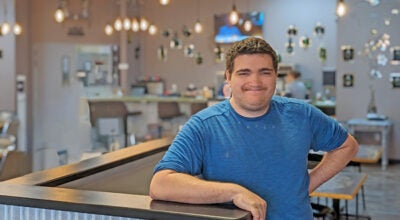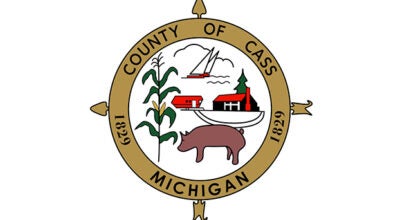Krasl dials up Touch Tone Art
Published 10:24 pm Thursday, June 17, 2010

Anna Metz joined Krasl Art Center in St. Joseph in 1989 and became executive director in 2006. (The Daily News/John Eby)
By JOHN EBY
Dowagiac Daily News
Krasl Art Center Executive Director Donna Metz visited Dowagiac Rotary Club Thursday as the guest of her step-brother, attorney Mark Herman, to talk about Touch Tone Art and Culture, self-guided cell phone tours which offer audio support explaining visual art.
But since “we’ve been in a brouhaha in the news,” she feels like she’s seated on at least a warm seat if BP CEO Tony Hayward occupied the hot seat during withering congressional criticism and questioning Thursday on Capitol Hill.
“It kind of worked out,” Herman said, referring to his original intention to present her program in April.
Instead, it coincides with the Building Blocks controversy, which moved a Williamston sculptor’s trio of figures into the gallery and out of public view.
In fact, Mark Chatterley will be in St. Joseph today for the Biennial Sculpture Invitational opening reception from 5:30 to 8:30, to which the public is invited.
From the gallery, they will move to the Margaret Beckley Upton Arboretum on the river channel “because we’ve placed sculpture along there, too, that’s part of the exhibit. You’re all invited.”
“We worked with him in November and December of ’09, so we’re familiar with him. In no way were we trying to be provocative,” Metz said. “He’s a master sculptor, but we heard the upset voices of the community and moved it into the gallery. Art is supposed to evoke emotion.”
“It” is three nude figures made of ceramic clay.
One figure’s face is near the torso of another while a third is on top of that.
Critics dissed the sculpture as “disgusting,” indecent and mindful of an “orgy.”
Chatterley has been quoted as saying Building Blocks depicts how we’re all products of generations that have gone before us and their experience.
He insisted he did not create the piece with sex in mind. If he had, it would be “more risque.”
He pointed out that the figures are androgynous.
This is the first time it has been shown in public display. Previously, it was seen only in competitions and galleries. It never elicited this kind of backlash.
Curator Tami Miller was quoted as finding the sculpture “playful” and exuding “joy and hope.”
Metz, for her part, saw tumblers and acrobats.
One unintended benefit is that people are paying more attention to the artwork than before.
“Next to the British Petroleum spill, the Krasl Art Center is probably the biggest news story in the nation. How fortuitous,” Herman quipped. His father married Donna’s mother 43 years ago.
Metz, who became executive director in 2006, has been with the Krasl since 1989.
“Development of this program (Touch Tone Art and Culture) is a great example of how different organizations within a community can collaborate to put together a fine program. More than two years ago I was contacted by a New York company selling the wireless system providing tours at the taker’s own time and pace, plus audio support for the visual experience.
“It tapped us into a young adult market,” she said. “We primarily served an older demographic. We thought this would help us capture teen-agers and young adults. We can make changes to content very quickly and easily. Staff time is minimal in maintenance. We can check the demographics of our visitors, where they come from,” which turns out to be from as far as Colorado and California.
“It allows us to keep visitors at our location, looking at artwork, longer,” Metz said. “Studies show most people look at a work of art for two seconds before moving on to the next.”
Each work of art is marked by a granite plaque designed by Bill Cooper of St. Joseph Monument.
There is a logo and a number, (269) 408-3053, to “dial-listen-learn about the art and culture of southwest Michigan.”
A second icon, the hippo known as Lotus, indicates a child-friendly item.
The program was made possible by a Berrien Community Foundation grant and support from Southwestern Michigan Tourist Council.
“Every new exhibit we have, we’re going to have a new cell phone tour. A lot of times you hear the artist himself or herself speak about the artwork,” Metz said. “Your minutes apply, but so many people have free anytime minutes, that doesn’t seem to be a problem. We also have two pay-as-you-go phones at the Krasl that people can check out.”
During the summer of 2008 Metz conducted cost and sound quality comparisons.
A board member on the St. Joseph City Commission suggested a municipal partnership, so the 36 sculptures were joined by 60 city monuments, statues and historic markers.
Miller was the point person for developing the brochure.
Bob Myers from the courthouse museum and Ken Potts from the heritage museum, among others, assisted Metz in writing scripts.
“We had a soft kickoff in February ’09 with the sculptures in the gallery,” Metz said, “then on May 22 of last year we kicked off the whole project with the historic markers. Abonmarche loaned us a staff person to create the map in the brochure. A lot of community members joined in and you’ll hear their voices on the tour,” from St. Joseph Mayor Bob Judd to U.S. Rep. Fred Upton.
In the future, the system will help market the Krasl.
“We’ll have the ability to text their cell phones” with alerts about upcoming events.
Visitors can record feedback, which forwards to Donna’s e-mail.
Metz comes from a “mixed family” – she graduated from Michigan State, her husband from Purdue and two sons earned engineering degrees from the University of Michigan.
As a member of the Twin City Players since 1985, her acting productions have also included Beckwith Theatre in Dowagiac.
Metz belongs to St. Joseph-Benton Harbor Rotary Club.
St. Joseph Art Association, a private, non-profit corporation, manages Krasl Art Center.
It started in 1963 with the first Art Fair on the Bluff (This year’s takes place July 10-11; Concours on the Bluff car show, Aug. 7).
The organization incorporated in 1967.
Olga Krasl was a founding member. She and George were industrialists who started LECO Corp.
Olga was an accomplished artist who studied in Europe.
The Krasls had no children, so wanted to bequeath a permanent art center to the community.
That was in the late 1970s, about the time George died. He never saw the building which opened its doors in July 1980.
The Krasl serves an estimated 100,000 people each year through its classes and events.
There is a staff of five fulltime and five part-time employees and a faculty of 30.
Membership of 1,065 is in St. Joseph, a city of about 9,000.
Krasl Art Center is located at 707 Lake Blvd.
Gallery hours: Monday, Wednesday, Friday and Saturday, 10 a.m.-4 p.m.; Thursday, 10 a.m.-9 p.m.; and Sunday, 1-4 p.m.
www.krasl.org
Facebook





